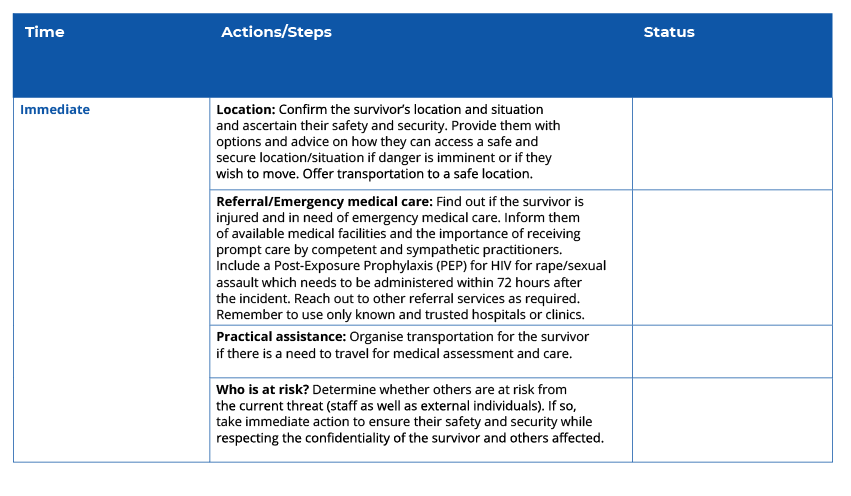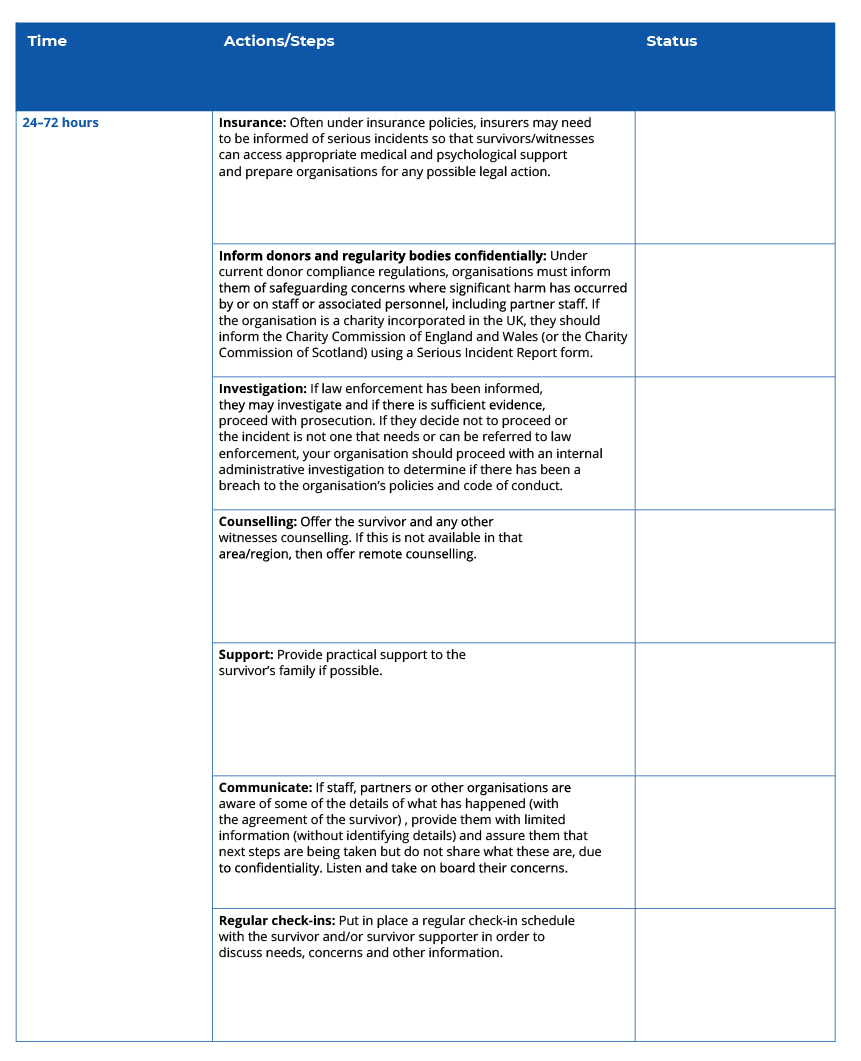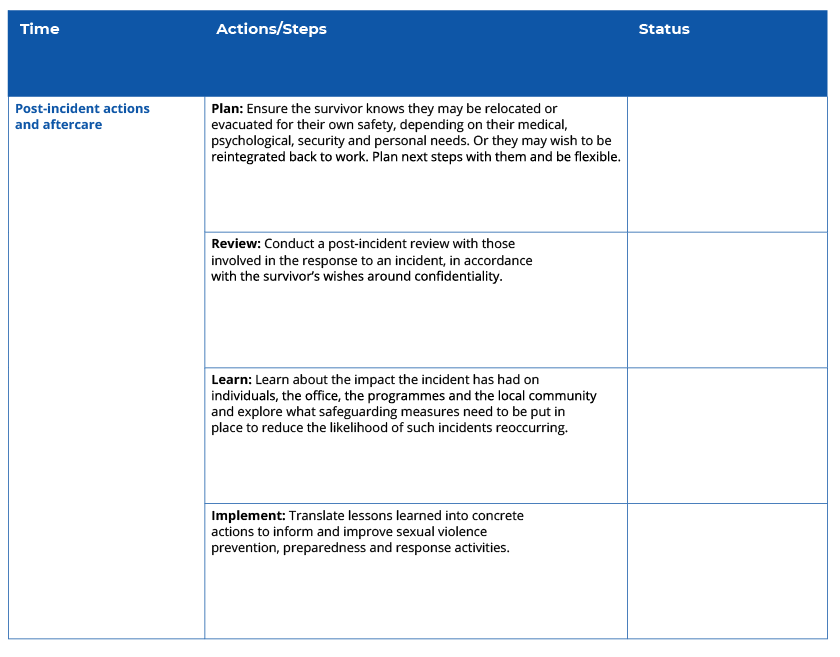Unit 4: Report and respond
4.5 Adopting a ‘survivor-centred approach’

© Christian Horz / iStock / Getty Images Plus
Mandatory reporting does have its challenges.
For example, how should aid workers balance their duty to report to a Safeguarding Lead if the survivor refuses? Or how does the organisation investigate a safeguarding concern under its ‘zero tolerance’ policy if the survivor wants to stay anonymous? Or if the misconduct committed is a criminal act, such as rape, and the organisation has a legal duty to report the matter to law enforcement, but the survivor refuses?
A ‘survivor-centred approach’ means the rights, needs and wishes of the survivor (or victims) are prioritised. For example, the survivor has a right to:
- Be treated with dignity and respect instead of being exposed to victim-blaming attitudes.
- Choose the course of action in dealing with the violence instead of feeling powerless.
- Privacy and confidentiality instead of exposure.
- Non-discrimination instead of discrimination based on gender, age, race/ethnicity, ability, sexual orientation, HIV status or any other characteristic.
- Receive comprehensive information to help them make their own decision instead of being told what to do.
Note: A “survivor-centred approach” is not a “survivor-led approach”. The organisational duty of care goes beyond the survivor as organisations must take into consideration the risk of the Subject of Concern committing misconduct again if they continue to stay employed or associated with the organisation.
This approach helps to promote the survivor’s recovery and their ability to identify and express their needs and wishes, as well as to reinforce their capacity to make decisions about possible interventions (UNICEF, 2010). Organisations must have the resources and tools they need to ensure that such an approach is implemented (Source: UN Women, Survivor-centred approach).
When implementing safeguarding measures, we should ask ourselves this question: ‘Will this action be in the best interest of the survivor and other potential survivors or victims?’ Therefore, it is important for organisations to carry out a risk assessment when discharging their duty of care when safeguarding known survivors, as well as other potential victims, from being harmed. Organisations should carry out an impartial investigation into the alleged misconduct to address the misconduct and eliminate any further risk.
|
Activity 4.6 Applying a survivor-centred approach What is your understanding of a survivor-centred approach? How would you exercise this approach if the survivor was a child or a person with disability? |
|
Activity 4.7 A SEAH scenario Apply what you have learnt so far to the SEAH scenario below. How would you as the Safeguarding Lead react in this situation? Make some notes in your learning journal. You are the Safeguarding Lead for your organisation. You are informed that Tasmin was seriously sexually harassed by another member of staff who has since gone on long-term leave. Tasmin wishes to go to the police so that justice will be served. The Country Director, however, informs you that in this country there is a high risk that the alleged perpetrator will be violently attacked and even killed while in custody, as suspected sex offenders are known to be assaulted by police and other inmates in prison. (© Adapted from Global Interagency Security Forum, Scenarios for Senior Leadership) |
Balancing the duty of care
![]()
Hasan, a Human Resources Manager based in Amman, has a question about balancing the duty of care.
Watch the video above to learn more about Hasan’s question and the response he is given.
Mapping of referral services

© Rawpixelimages / Dreamstime.com
Part of a survivor-centred approach is to provide survivors with information that is supportive and easily understood so that they can make informed decisions.
Organisations should map services to manage how they could respond to safeguarding concerns. It is worth being particularly attentive to medical services who provide sexual, reproductive health and psychosocial support services, and to women’s groups who provide safe spaces and/or refuges.
You will also need to consider whether these services have trained personnel to support survivors who are referred to them. Are they accessible for people with disabilities, and might any fees be incurred? This analysis will help you think about who is and who is not able to access each service. You should also consider how local ideas and beliefs about gender might influence access.
|
Activity 4.8 Mapping of referral services Use the table below to map out support services available to survivors of SEAH in the area you or your organisation work. Consider each service and the potential barriers there might be to accessing these services for different kinds of people. Include not just services provided by your own organisation, but also those provided by others operating in the same area. Remember that it is really important that this list of referral services is updated regularly and is easy for the staff and the people you serve to access quickly. Here is a writable version of the blank template shown below. You can type into this PDF form and then save it and/or print it. Expand it to list as many services as you are aware of – you could check with colleagues if there are any services other than those you have identified. As you undertake the activity think about what the challenges might be to accessing services and how they might be overcome.
(© Adapted from IASC PSEA Mapping Tool for GBV services) |
Mapping legal requirements
It is equally important to ensure you are aware of the legal requirements in the environment in which you work.
After all, ignorance of the law is not a valid defence, and part of exercising our duty of care is ensuring that staff and programmes are up to date on the key legal requirements.
Are you confident in the answers to the following questions? If not, then explore with your colleagues what the legal situation is:
- What are the legal definitions and understanding of sexual assault or rape in the country you work in?
- How does a survivor file a complaint and where can this be made?
- Is there a time limit for sexual assault crimes to be reported?
- Are there trained legal and other professionals to deal with sexual assault/rape?
- Does the law protect the identity and dignity of the survivor?
- Could a prosecution go ahead even when the survivor withdraws from the process?
Response checklist

© baona / iStock / Getty Images Plus
It may be helpful to have a response checklist to support you in your role if you are the Safeguarding Lead or Focal Point and you have to manage safeguarding concerns which are reported to you.
Below are examples of a response checklist – split into four time periods. Remember you will need to obtain the survivor’s informed consent before taking some of the steps mentioned.
Here is a writable version of the response checklist. You can type into this PDF form and then save it and/or print it.




(© Adapted from GISF’s Sexual Violence Response Checklist (Tool 4))
